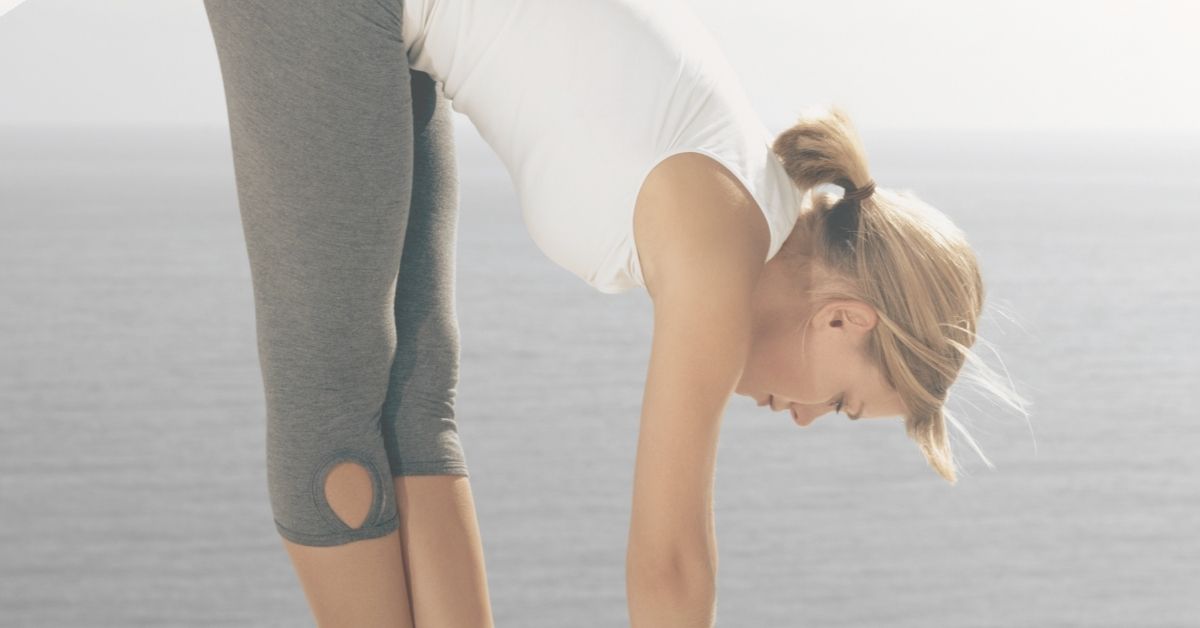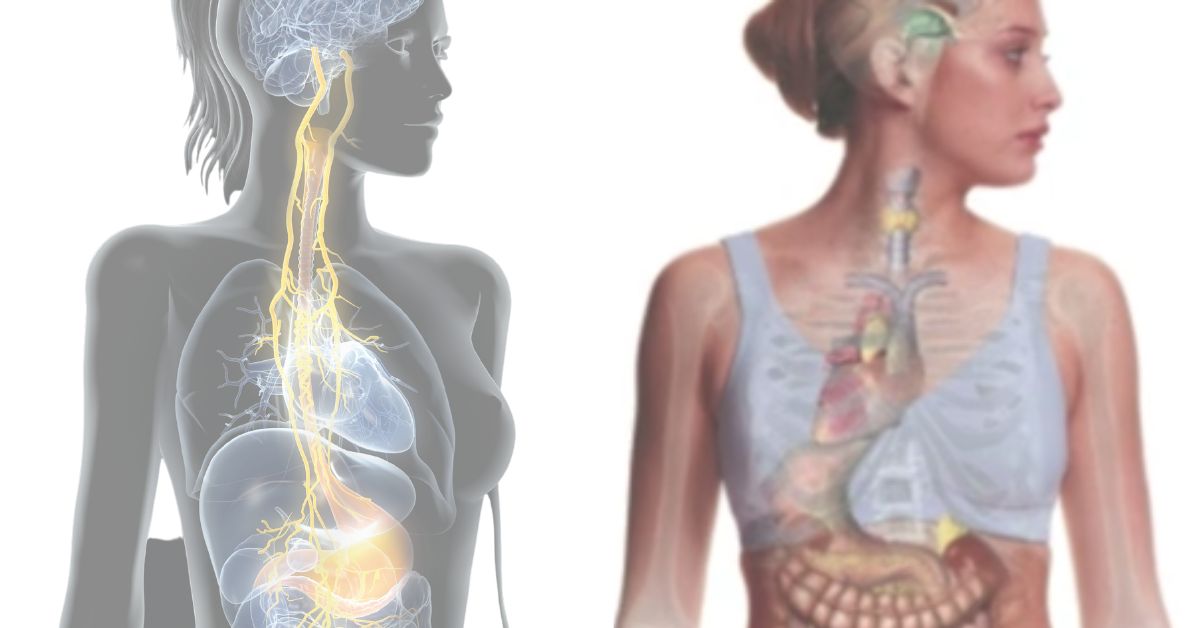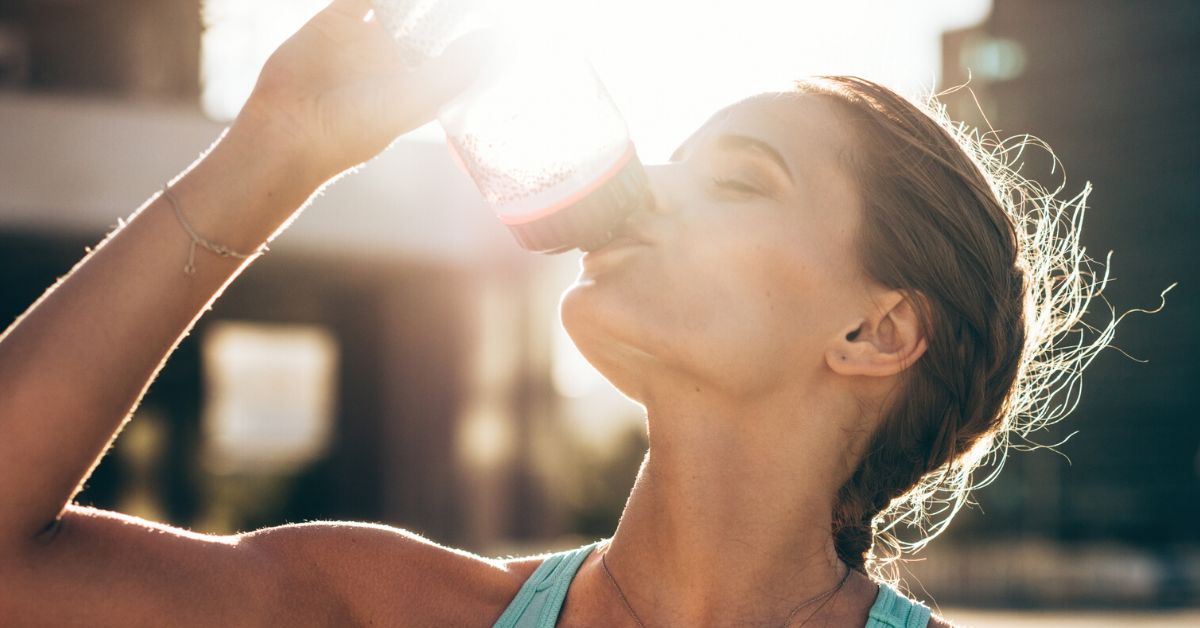Legs Up on Wall Position Works Wonders!
Placing your legs up the wall provides several physical and mental health benefits.
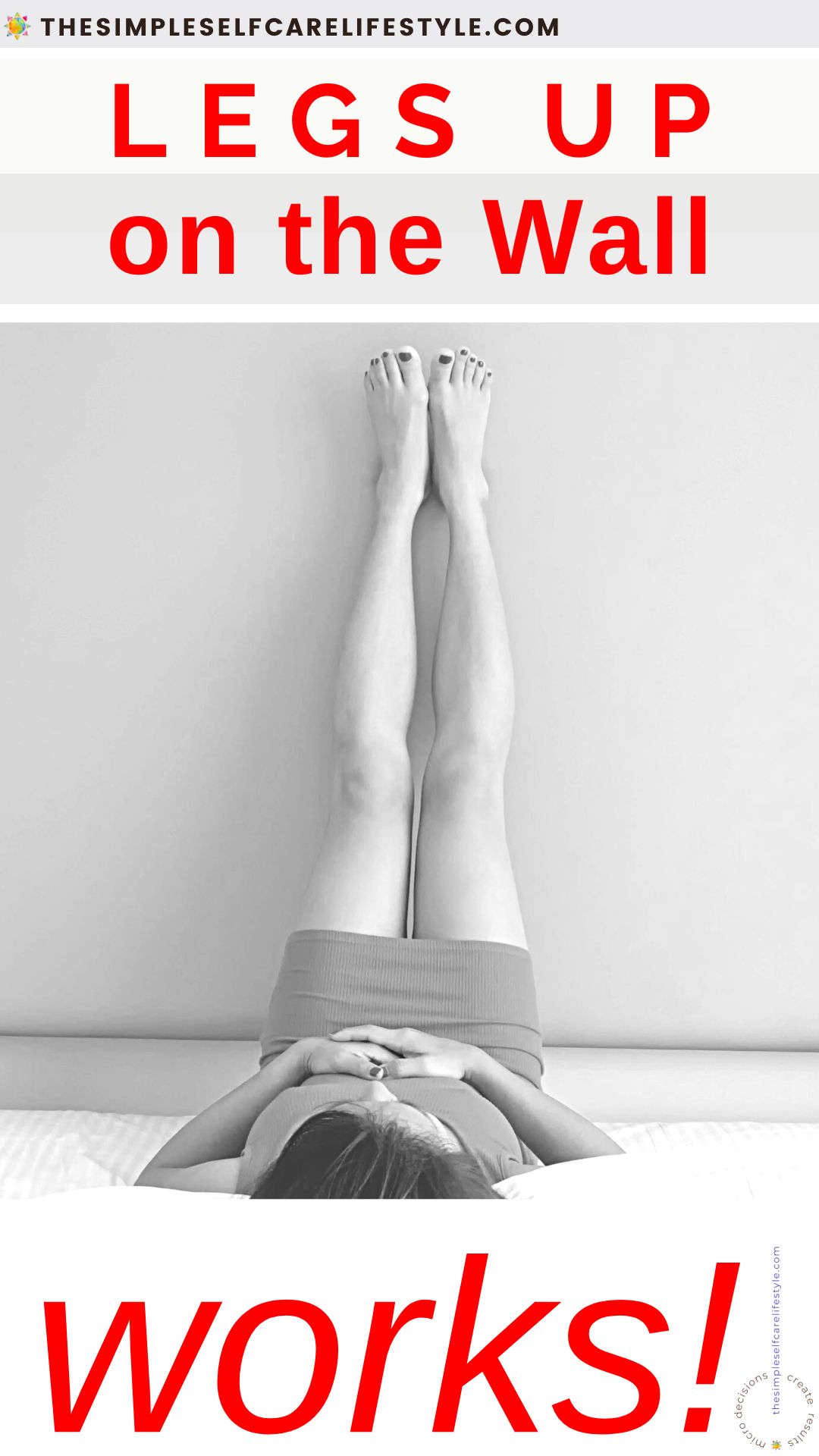
Today’s Post is in response to a subscribers question:
Q “mo, I’m overwhelmed, stressed, and I really do want to get back on the self care track. I feel like I can only handle one ‘to-do’ to get started. If you could suggest just one thing I could focus on, what would that be?” Thanks! K.L.
A: If I had to choose one thing, I would choose something I happen to do each evening.
It is a passive position that is well documented to benefit multiple systems while also strengthening vagal tone, which positively-
- reduces stress
- improves digestion
- sleep
- mood…
Because we know from our 1 FOCUS- Core Concept 1 that all our systems are interconnected and dependent on each other, Legs Up the Wall will provide even more than I have listed here.
So my answer is- The Passive Legs Up the Wall Position with guided breathing.
Here’s Why and then How.
Physical and Mental health benefits.

A Few Physical Benefits
Positioning yourself on your back and placing your legs up can help to:
- improve circulation (4)
- support lymphatic drainage (plays a big role in your immune system) (8)
- ease leg heaviness, and varicose veins (9)
Both Blood and Lymph circulate in one direction, and that is toward the heart.
The veins and lymph vessels benefit when your legs are up the wall because you reduce the resistance gravity plays.
This allows the fluids to move more easily toward the heart.
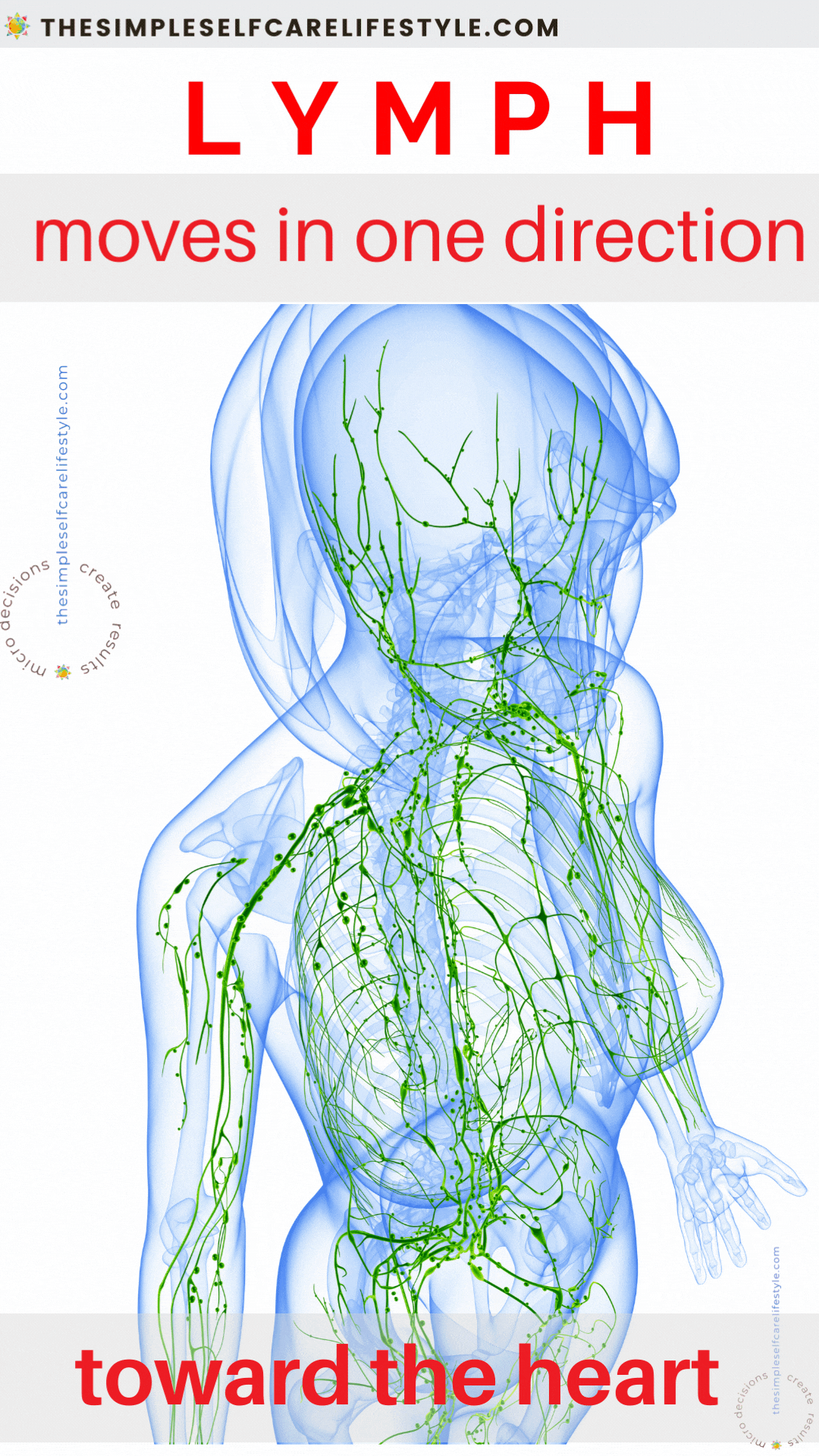
Research also points to benefits of legs up the wall like:
- improving digestion (1)(5)
- easing lower back tightness/sciatic nerve pain
- helping to reduce fatigue/insomnia (10)
A Few Mental Benefits of Legs Up The Wall
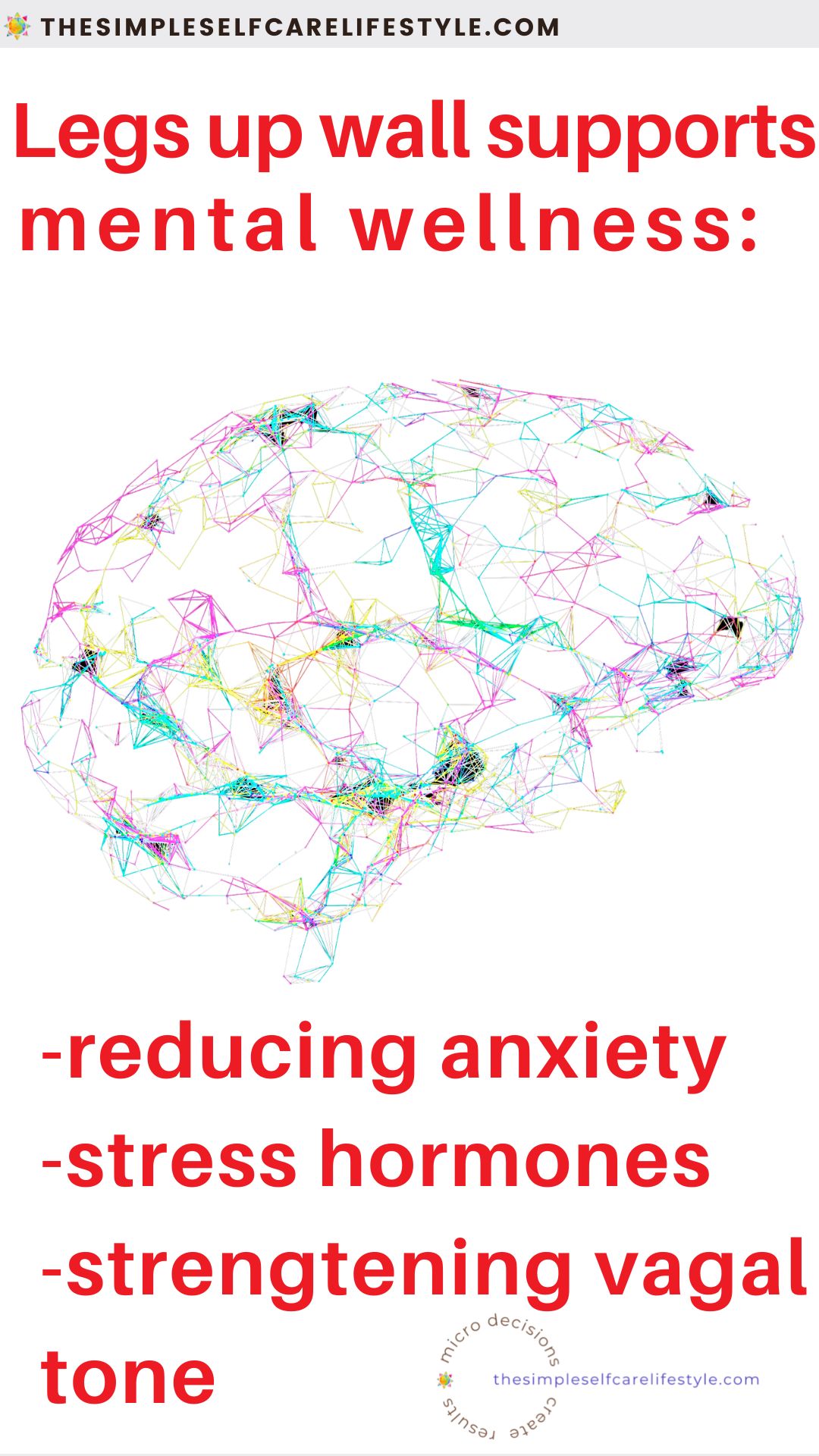
Positioning your legs up a wall each day can help you reduce physiological stress, anxiety and, over time, promote an overall sense of well-being and calm. (1)(2)
Don’t Let the Simplicity Lull You Into Thinking It Can’t Work.
While placing your legs up the wall seems too simple to be truly effective, it does work!
Passive postures ARE effective
Research shows passive postures such as lying on your back with:
- legs bent
- supported on a ball or
- up the wall
are effective.
soft inversions such as this pose have a positive effect on our vagus nerve and the baroreflex, suppressing our fight or flight response (sympathetic nervous system) and promoting feelings of rest and digest (our parasympathetic side).
(1)(italics, bold added)
Power posing not superior to holding a neutral posture to improve interoceptive accuracy or anxiety….
(2)(bold, underline added)
…State anxiety decreased and interoceptive accuracy increased after two weeks…
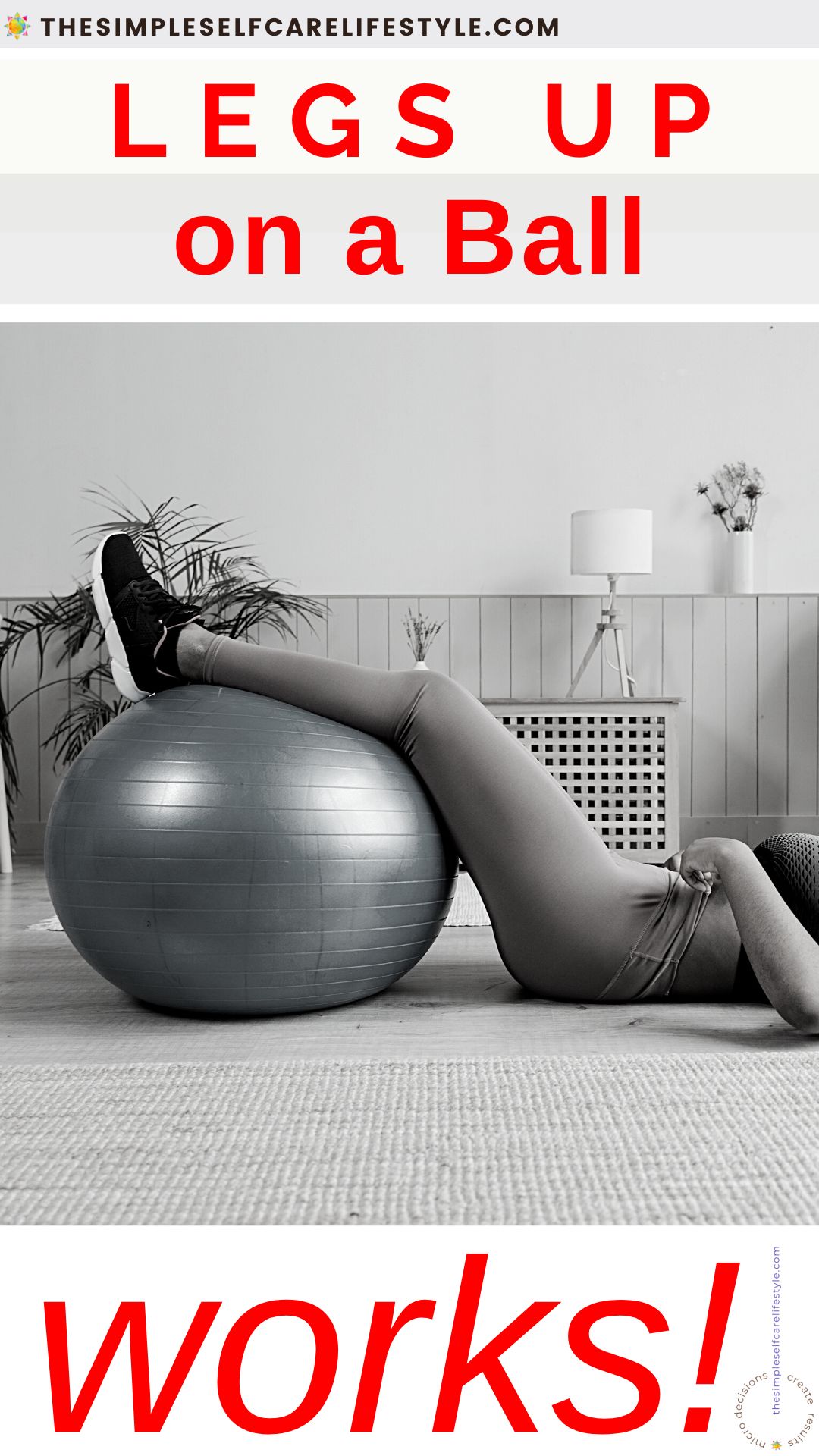
Legs On A Ball Works too!
A small study found that when it comes to specifically reducing leg circumference brought on by swelling from long days of sitting or standing for long periods, placing legs on the ball while positioned on your back reduced leg circumference a bit more than the legs up the wall.
This was attributed to the slight ongoing use of muscles to maintain the legs on the ball.
Legs Up Wall or Legs On Ball both work great!
Legs Up Wall doesn’t take extra equipment and is more passive than resting your legs on a ball, but both are great!
Use what works BEST for you, and more importantly, choose what is most convenient!
Now for positioning.
How to Position Yourself.

Legs Up Wall Positioning: 3 Options
- On floor legs up the wall
- Also, on the floor, but using a chair to rest legs on
- In bed, legs up the headboard or wall behind it.
Option 1: On Floor
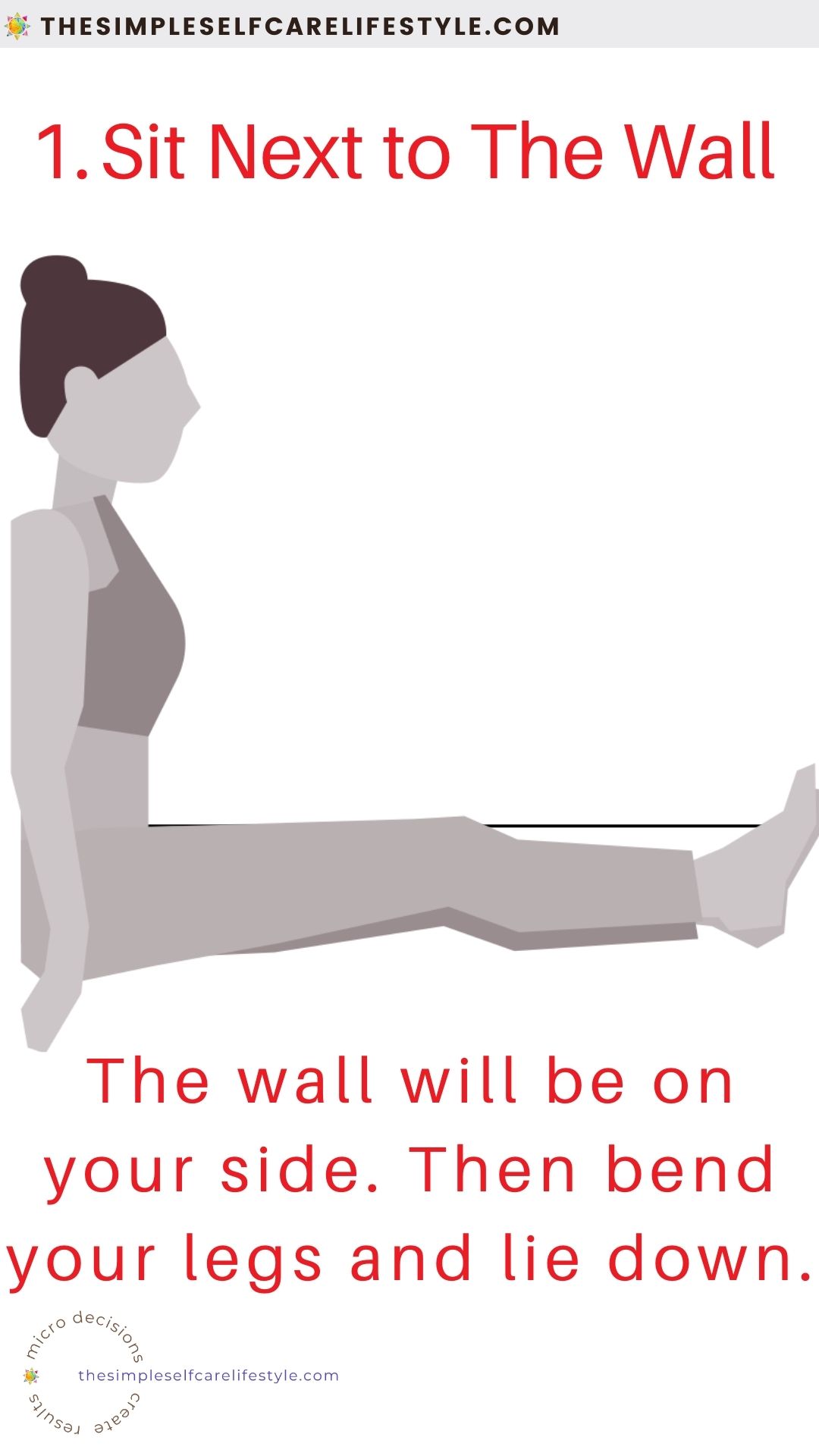
1: Sit on the floor at the edge of a wall. The wall will be to your side.
If you have tight hamstrings, sit further away from the wall initially.
For those of you who are very flexible, place your hip right against the wall.
It may take a few times to figure out the placement of where you should start, but it will be easy to get in and out of the position over time. It is normal to fumble about the first few times.
2: Swivel to position yourself lying down on your side.
As you swivel, you simultaneously bring your legs up, placing your heels against the wall.
That’s it!
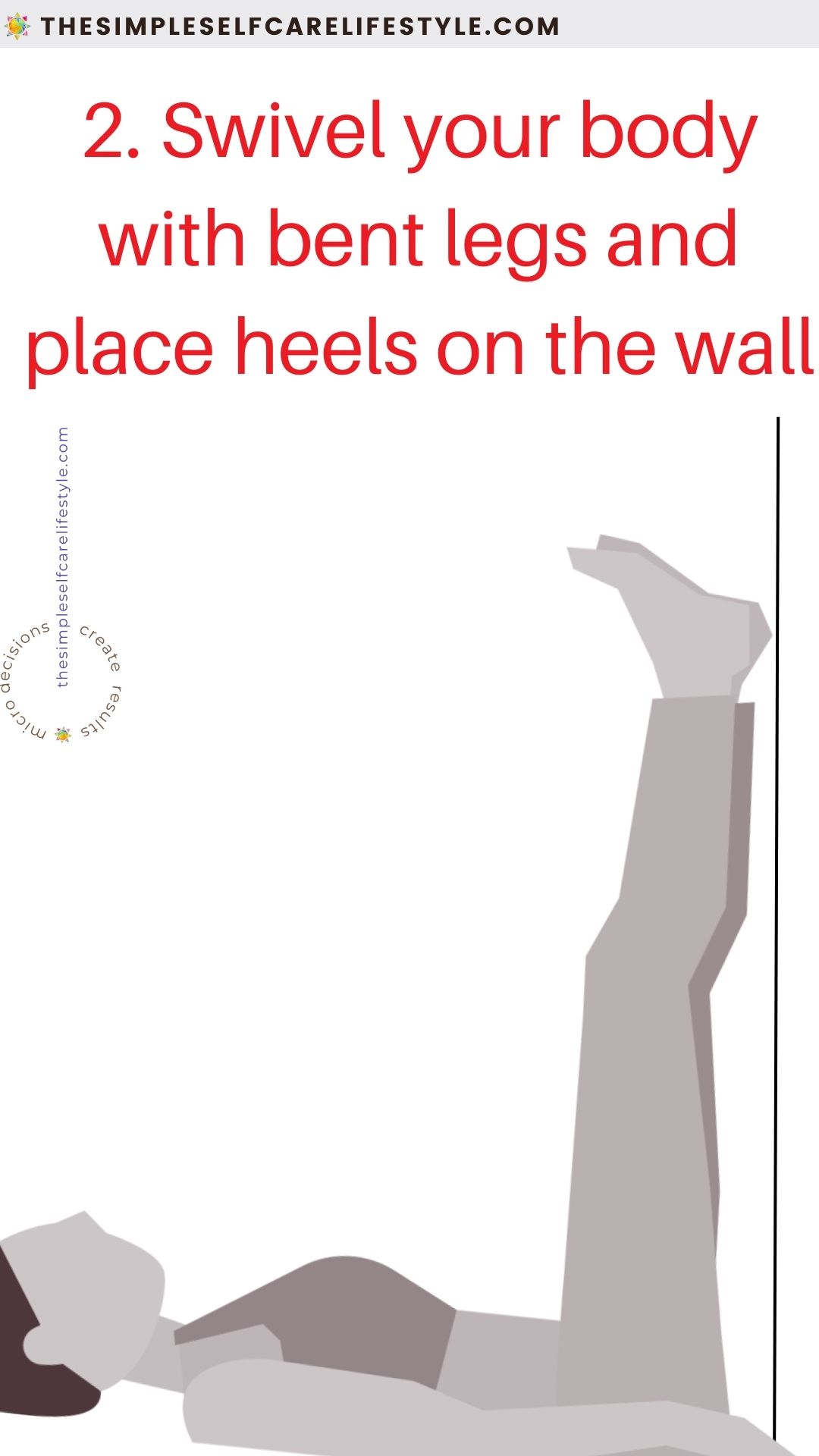
It is time to relax in the position,
Adjust where needed, then fully release the tension in your:
- head
- shoulders
- and back
Hopefully, you will begin to feel you are sinking into the surface beneath you.
Note: We are not trying to ‘stretch’ our hamstrings — if your legs are tight, simply keep them bent to where it is comfortable.
Hamstrings Waaaaay Too Tight?
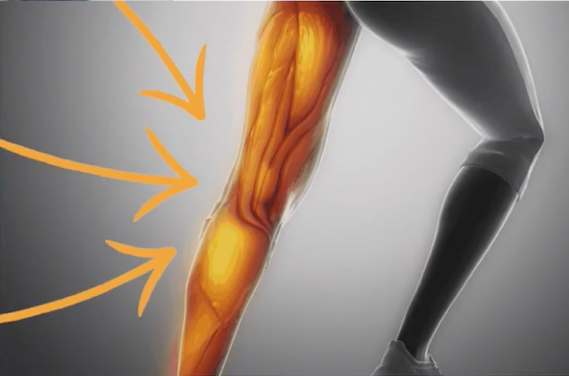
Use Option 2: On the Floor Using a Chair
You can rest your legs on the seat of a chair. Your legs will be bent, and the lower leg will be positioned on the seat of the chair.
This is similar to the ball position, but instead of your calves balancing on the ball, they will rest passively on the seat of a chair.
The chair position is passive, like the wall position.
If you are focused on reducing leg swelling, the Legs Up on a Ball is the best choice for you.

Self-Care information, tips, tools, products & programs
If You Can’t Get Down Onto the Ground & Back Up
Use Option 3: In Bed.
Place your feet up on the headboard or up the wall behind it.
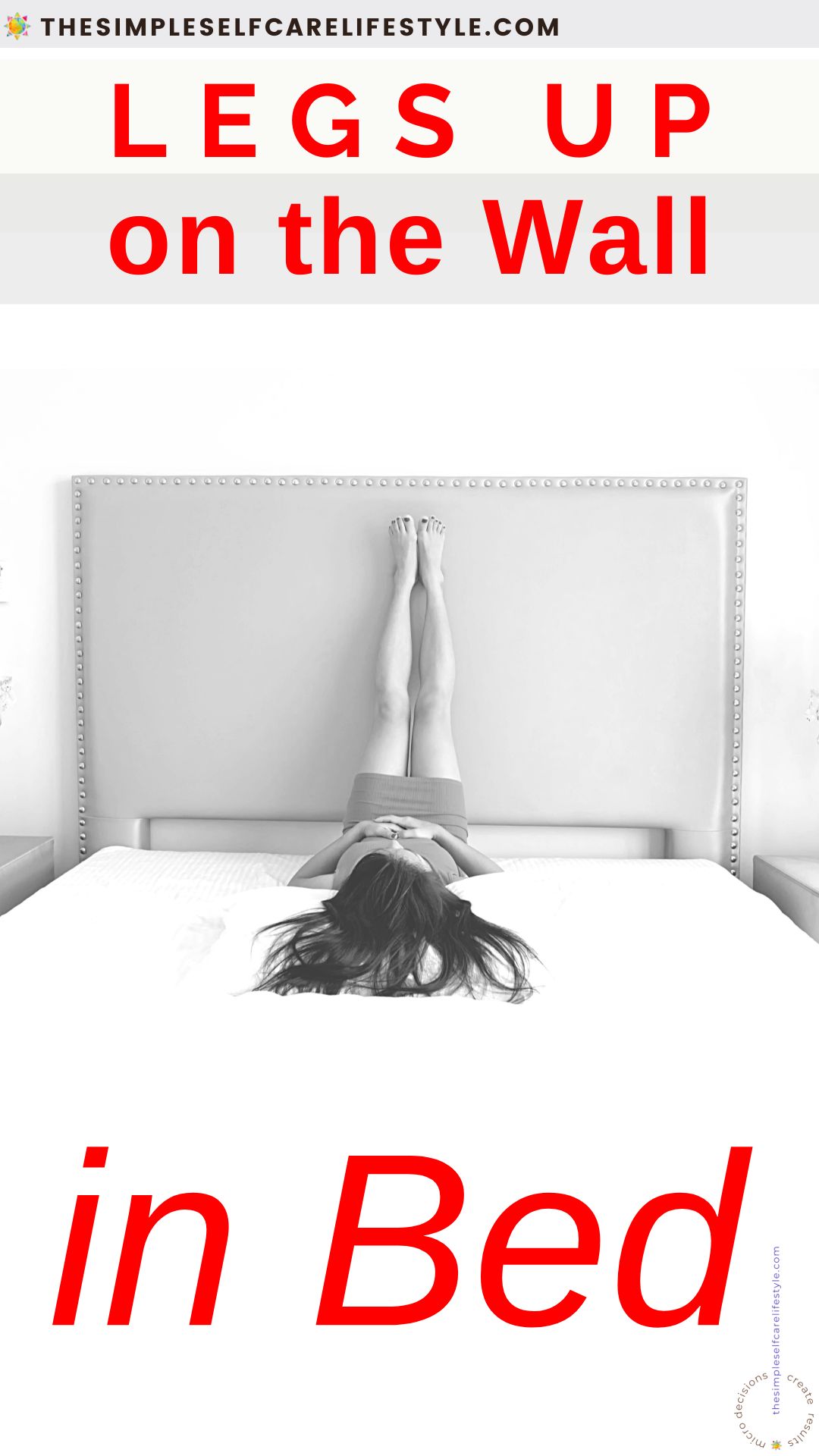
Those are the 3 legs up positions.
Each will help your body unwind, reset, and repeated daily, will stack up benefits.
Taking it to the next level is simple, adds no additional time, and offers exponential benefits.
Simply add the guided breathing with theta music.
Once Positioned With Your Legs Up, Use: Slow, Deep Breathing
When you are comfortably positioned, take a moment to soften your eyes, jaw, and forehead.
▶️ Push play on the guided breathing and relaxation of your choice.
Here is an example if you are new to the breathing technique that calms your nervous system.
On the Video Topics page, there are Day Time AM and PM versions for you. A variety including 1-min, 3-min, 30-min up to 9-hour versions.

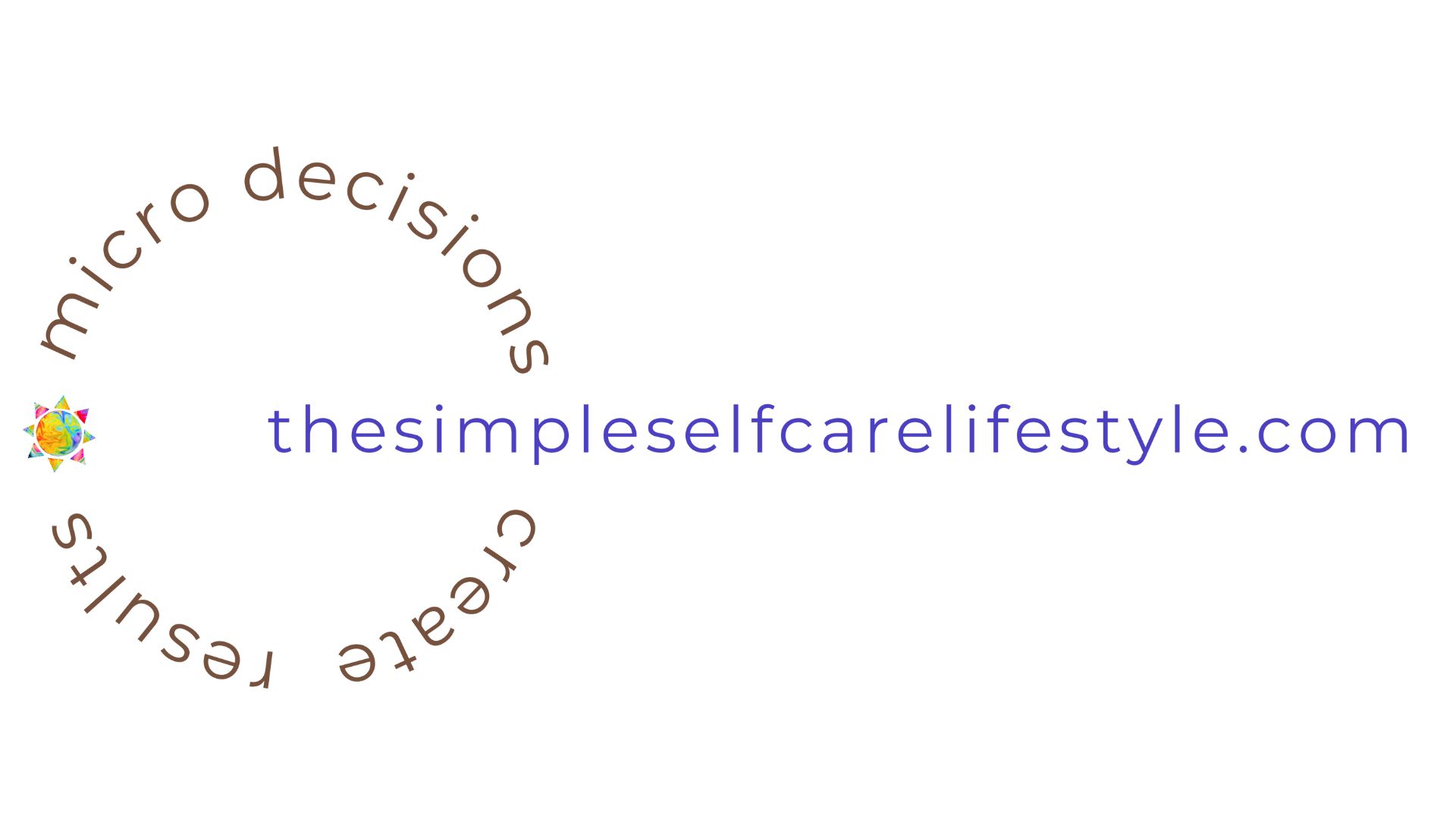
Why use Guided Breathing?
Exponential Payoff for the same amount of time.
Legs up the wall is already helping to calm your nervous system, and by using diaphragmatic breathing, you’ll layer on a multitude of additional benefits. A few examples:
Core strength improves by strengthening the diaphragm muscle, which strengthens the Pelvic floor muscles. The E for E post goes into detail about how that works.
Adding E for E Breathing technique will also:
- Work to Strengthen your core
- Involve pelvic floor strengthening.
- Help to Increase Lung Capacity.
- Oxygenation of your body increases.
- Vagal tone strengthens, helping you to break the Stress Loop
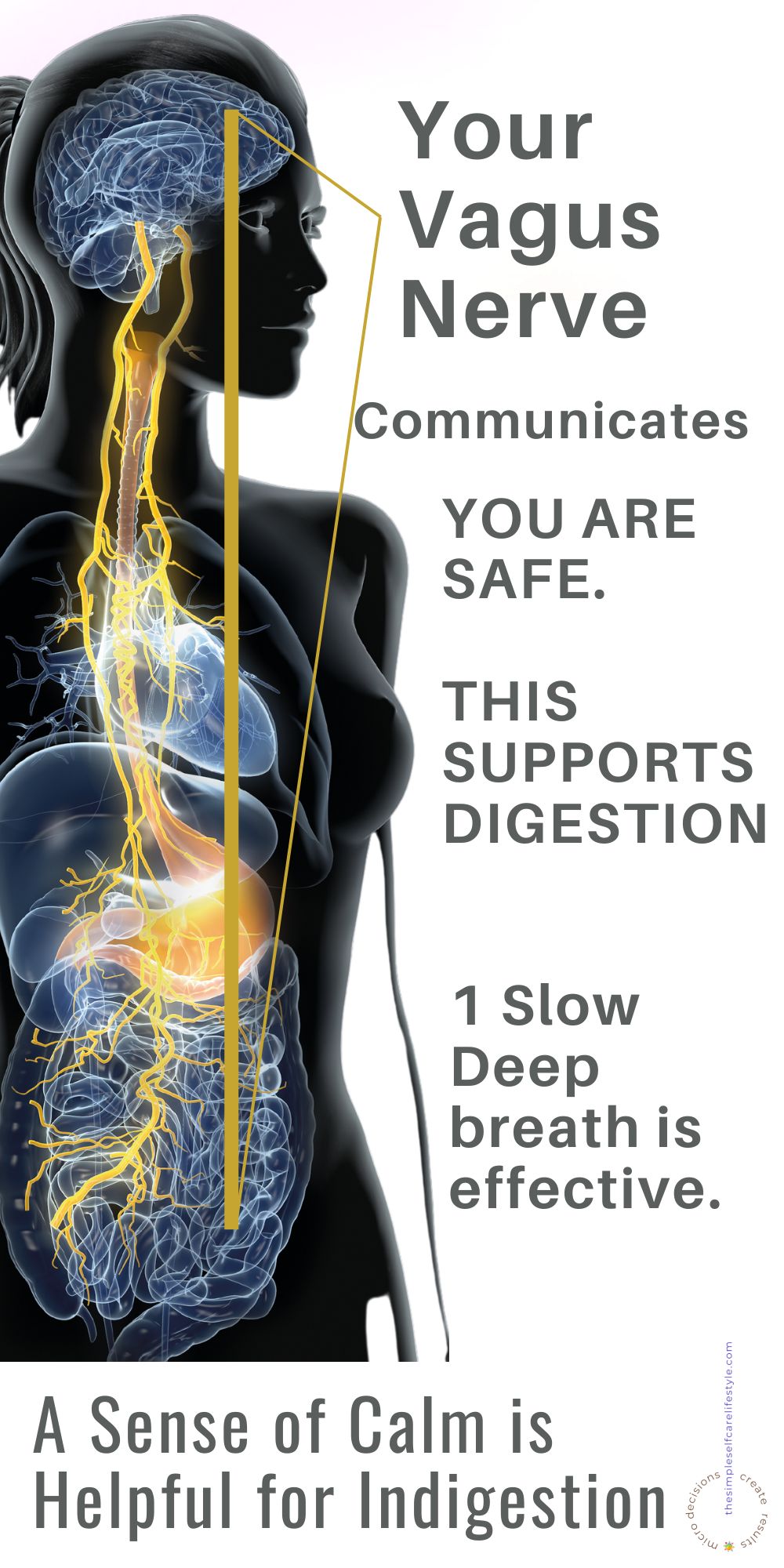
A 2019 review found that regulating breath through diaphragmatic breathing exercises can lower levels of cortisol, the stress hormone. One popular diaphragmatic breathing technique is known as the three-part breath.
(6)
…various breathing practices are used to expand the lung capacity and to balance the breath in order to impact the functioning of the cells by calming the nervous system.
(7)
IMPORTANT ⚠️ Getting Out Of The Position
Please Note: When you’re ready to come out of the legs up the wall position:
1- Bend your legs first; take a moment. (5-10 sec.)
2- Then, bring your legs down to the floor as you swivel.
The wall is now again at your side.
3- Take another moment to slowly, easily take one or two deep breaths before you return to sitting.

RE-CAP:
Placing your legs up the wall each day provides a number of physical and mental health benefits.
Physically, it can help to improve circulation, reduce swelling, and support venous and lymphatic drainage.
Mentally, it can help to reduce stress and anxiety and promote a sense of calm.
Additionally, it can help to reduce fatigue and insomnia, improve digestion, and ease any lower back or sciatic nerve pain.
It is the one item I would choose K.L. because this 🎯 One Focused Action (you called a ‘to-do’) will help you
- feel better,
- sleep better and
- ultimately help be a part of reducing the overwhelm standing in your way.
Thanks for sending your great question my way K.L. I am sure many others are feeling the same overwhelm and will be happy to have a clear, focused action that helps the ENTIRE BODY.

Who Should Check With Their Health Practitioner First?
- If you have glaucoma.
- Issues when positioned on your back.
- Those with severe back problems/neck issues.
- Heart disease
- Kidney failure
- Uncontrolled high blood pressure.
If you have any of these conditions, Legs Up The Wall may be perfectly fine and even beneficial, but first, get the clearance from your practitioner for your bio-individual body.


THe simple self care lifestyle
Simplify
Have a question you’d like to send my way? 💌 [email protected]

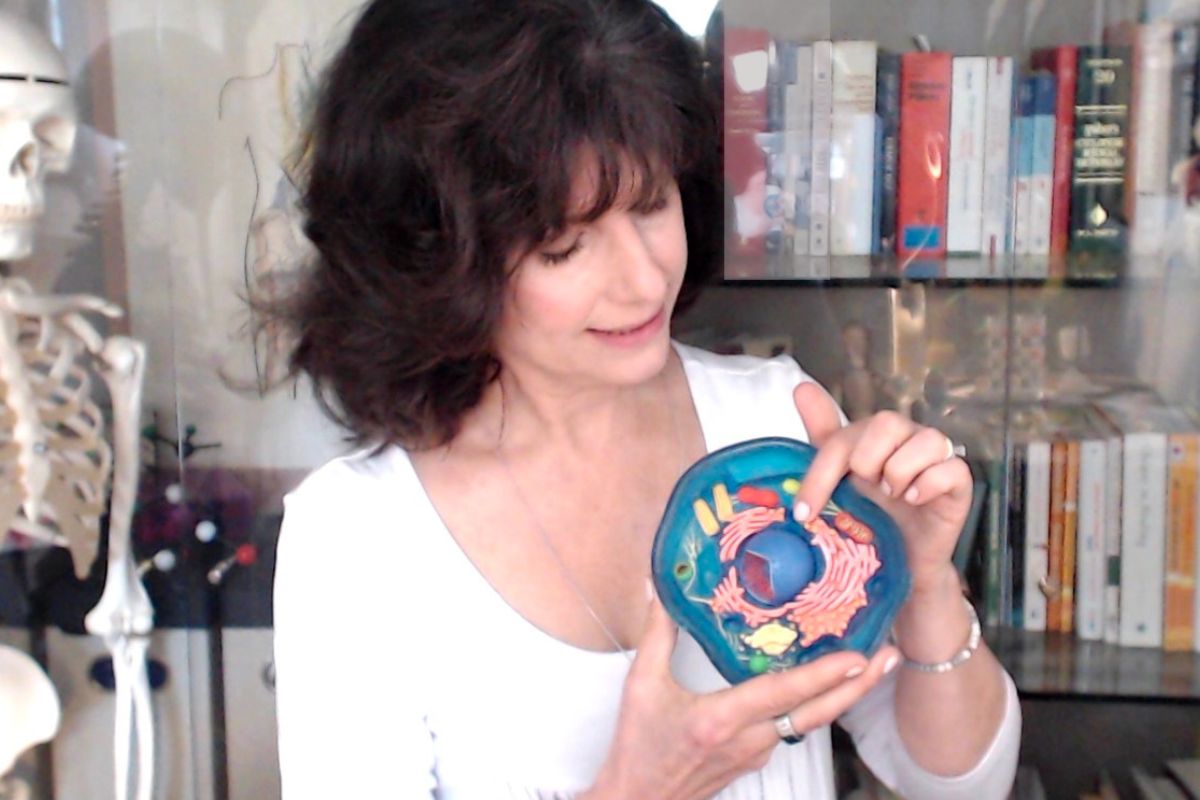
Posts of Common Conditions
Metabolism, Neck Hump, Fatty Liver, Indigestion…
Feel Better, Look better, Live Better than you ever imagined!
More posts that may interest you can be found here. Additional Categories of Posts are listed below the References/Resources List for you as well.
References/Resources for you
References/Resources continued…
self care
Post categories
